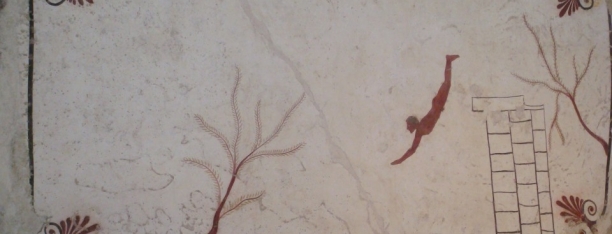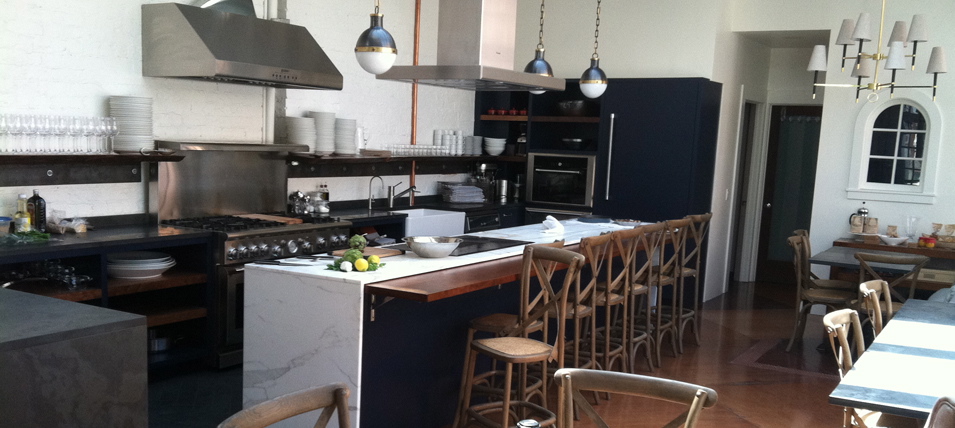I Love You—now hush~
Yesterday Richard sent a book title to me that perfectly captured a lunch experience with a French couple that we had in Venice. But before that, let me tell you about one of our first lunch experiences in Venice—a very popular inn and restaurant that was ours alone one day.
Before we take any trip to Italy we always chat amongst friends to see who has been where and where they ate while they were there. Facebook had enabled this line of questioning to go far and wide. A friend of mine in New York mentioned that he had an incredible meal in Venice at Antica Locanda Montin. Best known for their outdoor garden dining area, covered by a huge wisteria arbor, this inn and restaurant is packed during the warmer months of the year.
We weren’t exactly sure of where the restaurant was, which ended up being par for the course for us in Venice. It is on the island of Giudecca, the island just across the lagoon, which has a more open-air feeling to it than the rabbit run atmosphere of Venice. Trust me, we twisted and turned, took the wrong footbridges, and doubled back before we arrived at the doors of Antica Locanda.
When restaurants are not open in Italy they appear to be much more than closed. They look as if they are out of business. Shutters are closed, curtains drawn, and sometimes, as in Rome, the protective garage door, which covers the entire restaurant front, is down and locked. Outside there are no tables or railing enclosures, no potted plants, and no appearance of any recent activity. The complete flipside of this is when an Italian restaurant is open. Magically, the non-existent seating tables with their chairs, potted plants, railings, and menu placards appear from nowhere crowding the front of the restaurant with life. The shutters and curtains are opened wide, and in warmer weather, the front door is propped open allowing the hustling waiters to efficiently serve their hungry clientele, both inside and outdoors.
The front of the Antica Loncanda was neither fish nor fowl. The outside was void of warmer season dining and, although the shutters and curtains were open, there seemed to be a “we’re not open” atmosphere about it. We paused for a moment outside the door wondering what to do. We were starving and had no other options in mind. Suddenly a white-coated waiter opened the door and invited us in. In Italy, waiters, in addition to their table duties, are also street hawkers, luring and enticing passing pedestrians into becoming patrons.
In America, if you walk into a restaurant and there is no one there, I bet your immediate reaction is the same as mine—“Uh-oh, this place must suck.” We paused again, looking at each other trying to quickly assess if we wanted to eat here. We had been walking all morning and it was almost 2:00 p.m., so we decided we’d suffer through this restaurant and remind our friend that his recommendation was way off the mark.
There was one other customer, a round little man with a large lens camera sitting at a table with an Italian man who seemed to be the owner of this inn. The table was strewn with the remnants of a large, multi-course meal and several opened, but not emptied, bottles of wine. I wondered if the camera man was a photo journalist or a food writer for a travel magazine.
The menu was full of wonderful sounding dishes, mostly seafood, and our expectations for this meal started to change for the better. We ordered our antipasti: smoked tuna carpaccio, thinly sliced, served on a bed of celery greens with olive oil, lemon juice, and pomegranate seeds; polipetti (small baby octopus), grilled and served with the same oil and lemon vinaigrette and pomegranate seeds. WOW! The tuna was the most amazing thing. My grilled octopus were great, but the tuna was the star of the show. (Check out my guest video on dishKarma where I talk about this meal.)
We only ordered a primo (the first course, usually pasta), opting to keep lunch light by skipping a secondo (the second course, usually meat). Two plates of handmade tortelloni with arugula, tomato, and basil were brought to the table. Buonissimi! (*see the photo above)
After our meal, I poked my head out the back door, which revealed the famous garden arbor. There was something beautiful about its early winter desolation. I can only imagine what a wonderful place it must be to dine in the summer—under lush green leafed vines dripping with purple, grape-looking wisteria blossoms. We will definitely have to suffer the summer crowds to come back here and find out.
The biggest lesson I learned here was “Don’t judge a restaurant by the amount of filled tables.” Our lunch was so good and had we given in to our initial misgivings and left, we would have missed one of the best meals of our trip. Our friend in New York was spot on. Thanks David!
Now on to our next day’s lunch with the French couple:
We don’t always look for 4-star restaurants to dine at while we are on vacation. Many times we look for what is around us when we decide that we have seen enough sights and NEED to eat. Sometimes we stumble upon an amazing meal and if not, we always come away with a fun story.
We spent the morning wandering our way through the streets of San Marco, stopping to photograph a really cool building, and ending up at the Fortuny museum. A morning of modern art can make you hungry, so we decided to walk back to our hotel and stop for lunch when we passed something that looked interesting.
We walked for a while, window-shopping, before finally crossing over a footbridge, deciding we were starving, and passed a restaurant where the people seated at outside tables, along a canal, were mostly eating pizza. Pizza and a couple of glasses of wine sounded like a great way to spend lunch so we stopped at this trattoria/pizzeria and were tightly seated at a table next to a middle-aged French couple.
Richard ordered a pizza Napolitano—a simple red-sauced pizza with anchovies and capers. I had the pizza Diavolo…Devil’s pizza…a simple red-sauced pizza with spicy salami. Any time you see the word diavolo be prepared for spicy. The Devil likes it HOT!
We were enjoying our pizza, watching the gondolas pass by our outside table, using our Italian with the waiter—he was very patient—when the French gentleman, who might as well have been our dining companion we were packed that tight, leaned over and asked if he could borrow the olive oil bottle on our table. To say he “asked” really means that he leaned over and said, “Excusez-moi” pointing at the olive oil bottle and then to himself. Hand gestures truly are the one language we commonly share, regardless of our country of origin. “Certo, certo,” I said, answering in Italian since we had just been speaking to our waiter and my brain hadn’t made the switch to English yet. (I have to admit that when I meet someone speaking a foreign language I always want to answer them in Italian, since it is the only foreign language I know. If someone Asian were to ask me a question in their native tongue on the streets of Chicago my knee-jerk reaction would be to answer them in Italian. It makes no sense—I am just silly like that.) “Of course, of course,” Richard said to the Frenchman at the same time, his response was colored with a little Southern flavor.
This little exchange opened the floodgates of conversation with the Frenchman. He asked if we were Americans…that was an easy enough question to decipher from his French. We asked if he spoke English or Italian and his answer was “No.” His wife, a beautiful dark-haired woman, smartly dressed with a pashmina expertly draped about her shoulders said that she spoke a little English. She instantly became her husband’s translator. He started asking us questions, which at times we could get the gist of because the French was similar enough to Italian and English words. When we were utterly at a loss for what he was asking, we three men turned our gaze upon his wife who would pause, put her fork down on her plate, and translate.
Having lived with Italians for a month, I have learned that when speaking to someone who understands only a little English it is best to keep one’s responses simple and to the point—save the 3+ syllable words for someone who gets it. She was being a very good sport, but at one point her husband asked her to translate something into English for us and she paused, still holding her fork this time, considered his request, and answered, “Mon chér, il est trop difficile à traduire.” We all laughed. Even we could figure out that she was at a loss on how to translate his complex French question using her very simple knowledge of English. Slowly we all figured out that he was asking us how life had changed in America given the financial crisis. We answered and again he asked another complex question. We all gazed at his beautiful wife, who put down her fork this time, reaching across the table to kindly touch his forearm, and said,“Mon chér…” We all knew her difficulty and understood her touch—“I love you…now hush!”
The conversation continued on through dessert and caffè and continued to be peppered with her “Mon chér…” when he exceeded her translating capabilities. We said goodbye to our luncheon companions and headed off toward our next adventure, pleased with the fact that we had been good ambassadors between America and France. For the rest of our trip we used “Mon chér…” between ourselves any time we asked the other something beyond our knowledge.
“Richard, how low did the water used to be in Venice?”
“Mon chér…” he would answer, grabbing my arm and shaking his head, as if he had been there 500 years ago.
“Mark, what is this incredible taste in my dish?”
“Mon chér…” I said shaking my head, as if I had the ability to identify some of the complex flavors in his simple pasta dish.
When Richard sent the book title to me yesterday and I discovered that the subject of the book was about the different natures of men and women. “I Love You—Now Hush” was the perfect translation of our lovely French translator’s care for and exacerbation with her husband.
What a lovely way to tell someone to be quiet—“Mon chér…” “I love you…now hush.”
Ciao e a presto~
-Mark
(* the photos above are of the outside dining garden at Antica Locanda, our tortelloni, the building on the way to the Fortuny museum, and the restaurant where we encountered the French couple–if you look close enough through the bridge railing, they are the couple seated at the first table. His back is toward the camera in the black sweater, and you can just see her beige pashmina.).












Love this little story….